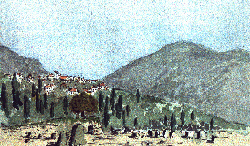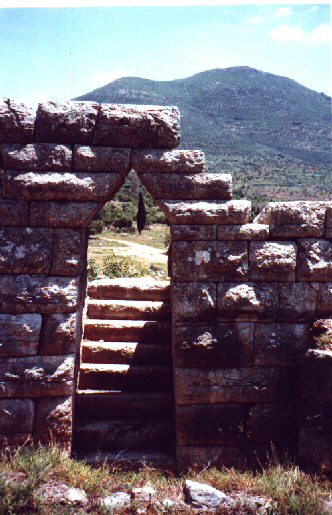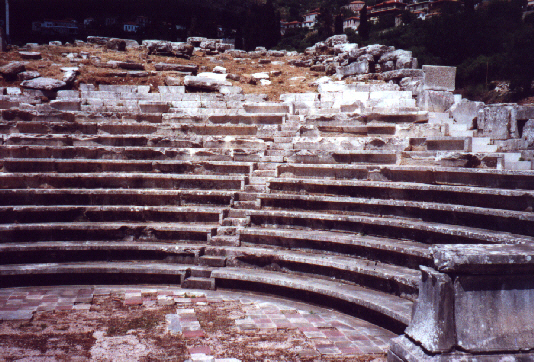Ancient Messene

|
Journey through Ancient Greece Ancient Messene |
 |
| The city of ancient Messene is set
at the foot of Mount Ithóme overlooking the
fertile plain of Makaria (one of Greece's most important
rice growing areas) to the sea at Kalamata, 15 miles
south. Mount Ithóme (2,630 ft.), referred to by Homer as
'ladder-like' (Ithome means 'step'), was,
according to legend, where the infant Zeus was
brought to protect him from his father Kronos, and where
he was looked after by two nymphs Ithóme and Neda. (In
the nearby village of Mavromati you can see the spring
where the nymphs bathed the baby!) The earliest city on this site was founded by Queen Messene, the daughter of King Triopes of Argos, who built an altar to Zeus on top of the mountain. By the 10th Century BC Messene herself was worshipped alongside Zeus. The region of Messenía was rich and therefore coveted by the Spartans just the other side of the Tayetos mountains and in the 8th century BC they laid siege against the Messeníans at Ithóme eventually defeating them and subjugating the inhabitants as 'Helots' (captives). The Messenian Helots and those of Laconia to the east of Sparta were essential to the Spartan economy, (Spartan men were forbidden any occupation other than fighting). In 669 BC, after Sparta was defeated by Argos, the Messeníans carried out an unsuccessful revolt. Over 200 years later in 465 BC, with Sparta weakened by the Persian Wars and by a devastating earthquake, the Messeníans seized the chance to revolt again. Athens reluctantly honoured the treaty made after the last Persian war and came to the aid of Sparta, despite misgivings at helping Greeks to enslave fellow Greeks, (it was OK to have foreigners as slaves!). But Sparta was afraid the Athenians would encourage the idea of democracy among the Spartans and insulted them by sending them packing, telling them 'they were not needed'. After a struggle of many years (the exact length is disputed) the Messeníans surrendered, but were then, under the terms of the treaty, resettled by Athens in Naúpaktos, the other side of the Gulf of Corinth. In 371 Epaminondas, philosopher, brilliant general and leader of the Thebans, trounced the Spartans at the battle of Leuktra using new military techniques of deep phalanx formation (fifty deep in places) and surprise cavalry charges in what Pausanius called 'the most famous of all battles won by Greeks over Greeks'. (The same techniques were later used by Alexander in his Asian conquests) After his success at Leuktra he then invaded Laconia with a force of between 30,000 and 40,000 men ending up in Messenia where the Helots were once more in revolt. In 369BC Epaminondas founded the city of Messene to give the liberated Helots a home and keep the Spartans at bay for good. The Messenían exiles from Naúpaktos came back. The Spartans were livid: 'the most painful thing is the prospect not of being deprived unjustly of our territory but of seeing our own slaves become master of it'. Messene was reputedly built in 85 days, and like nearby Megalopoli, was laid out on the grid system known as Hippodameion, a democratic system designed to apportion land fairly. Epaminondas was killed by the Spartans at Matinea in 362, the Messenians never forgave them and made him a hero. In 214 BC the Macedonian general Demetrios, son of Philip V besieged the city and died, with most of his troops, under the walls. When Pausanius visited Messene in the 2nd century AD it was a thriving political and cultural centre. However the words of the oracle: 'the bright bloom of Sparta shall perish and Messene shall be inhabited for all time' were not fulfilled; Messene was abandoned after the Visigothsinvaded in AD395. |
|
The Museum After years of promises the museum was finally opened in 2002. It is small and well arranged with good information in English. In the main room the far wall is covered with a life size photo of the site. There is a splendid marble statue of a lion attacking a deer, part of a grave monument behind the western portico of the gymnasium. A pretty Ionic column capital made of stuccoed sandstone from the inner colonnade of cult room K dedicated to Artemis Orthia has an innovative feature of a knot between the volutes. The marble statue of Artemis the hunter is a Roman copy of a 4th century BC statue and the statue of Hermes is a copy of the bronze original (which wouldn't have needed supports). The 3rd-2nd century BC stone Hekataion found in the Asklepion shows Artemis in 3 poses round a central column, it supported a stone basin. There is an amusing example of recycling in the statue with the head of a Roman emperor placed on a Hellenistic statue of - a woman! |
|
|
The Arcadian Gate
The new city was fortified by over 9 kilometres of extremely strongly built wall with 33 towers. Pausanius was most impressed with their quality: 'if you take the walls at Ambrosis in Phokis and at Byzantium and at Rhodes, which are extremely well-walled cities, the Messenian walls are stronger still.' These walls would have been a source of acute irritation to the Spartans who had never seen the need for walls. There were two gateways into the city, the Laconian Gate, to the east, of which little remains, and the Arcadian Gate to the north, which is well preserved, with an outer entrance flanked by square towers, a courtyard and the inner gateway which had a magnificent lintel formed from a nineteen foot block. |
 |
| The site Excavation of the ancient city began in 1957 and continues today, much of it is currently being restored; all the buildings mentioned by Pausanius, except the temples of Isis and Serapis, have now been identified. It is a very large and spread out site with plenty of olive and orange trees for your picnic. The first thing we see is the semi-circular limestone block wall of the theatre. In the wall at 20 metre intervals are pointed entrances, the first example of a style which was common in later Roman theatres and amphitheatres. A walk through the olive trees takes us to the main feature of the site, the Asklepion, now largely restored, it was built in 214 BC to celebrate the defeat of the Macedonians. This was not, according to Pausanius, a healing sanctuary as at Epídavros, but more of a civic centre and sculpture gallery. (There were more than 140 statues, most by the renowned local sculptor, Damophon, who also restored the famous statue of Zeus at Olympia when it was damaged by an earthquake.) |
 |
On the west side (nearest the theatre) are four connecting 'cult rooms' (oikoi) the best preserved of which is cult room K, the temple of Artemis Orthia and Phosphoros (torch bearer), now covered with a protective roof. It is divided into three aisles by two rows of two columns. Only the base now remains of Damophon's colossal cult statue of Artemis holding a torch. In front of the statue was a table for the offerings to the goddess. It was here that parents dedicated statues of their daughters in rites of passage to womanhood, similar to the ceremonies at Brauron. Room N housed the statue of the personification of Thebes and the smaller room Ni was dedicated to Epaminondas and had an iron statue of the hero.
Along the north side was the Sevasteion, a temple to the Roman emperors, with two chambers on a raised terrace divided by a monumental seven metre wide stairway, (you can see the remains of the two Corinthian columns which stood at the foot of the stairs). Beyond the sevasteion (north) are the partially restored columns of the 90 metre long late Roman stoa (3rd century AD) and beyond that was the agora.
The centre of the sanctuary was a quadrangle with a colonnade on all four sides of Corinthian columns topped with winged nikes. A drainage channel with settling basins is visible around the colonnade. In the middle of this was the Doric temple of Asklepios (although the dedication is uncertain as a chryselaphantine statue of Messene was found here). At the east end of the temple is the base of the very large altar.
| To the east of the altar and best
preserved (or restored) are three important buildings. In the centre is the imposing monumental Propylon, to the left of which is the Assembly Hall (or eklesiasterion), a small theatre or odeion, originally roofed, with a strong retaining wall. Much of the stone seating is complete and you can see a number of remaining red, white and blue tiles on the floor. To the right of the propylon is the bouleuterion, or council chamber, with a stone bench round three sides. next to this is the room of the Archives of the Secretary of the Council |
 |
To the right (east) of the sanctuary, are the substantial remains of a Hellenistic Bath (still being excavated in 2002). There were two fire places for heating water, a square pool or bathing chamber, around which was a raised paved area. A large number of coins from the 1st century BC were found here, a number of which were identical pairs, probably because, according to an inscription from Andania in 91/92BC, the entrance fee to the bath was two coins.
The stadium and gymnasium
To get to these (and you mustn't miss them!) you need to head south east from the Asklepion.
The horse shoe shaped northern end of the stadium has 19 wedge shaped divisions each with 17 rows of seats and staircases in between. Much of the seating remains including some of the posh seats with backs in the front row which were for the contest committee. Around three sides of the stadium were Doric stoas forming the gymnasium. The eastern columns lie fallen on the ground having been restored without iron clamps or dowels, the other two stoas are mostly still standing. The northern stoa was a double colonnade, and the western one ended in a peristyle court which was the palaistra. Behind the western stoa was the sanctuary of Herakles and of Hermes. The propylon of the gymnasium with its four doric columns have been restored.
Leave plenty of time to get back to the coach - it's a long way!